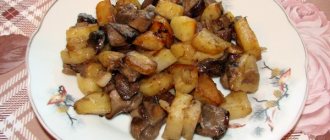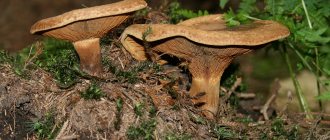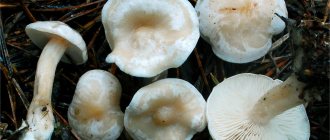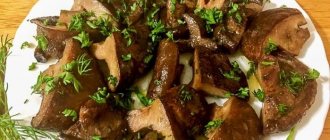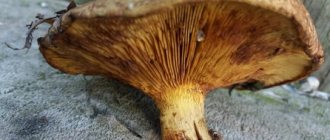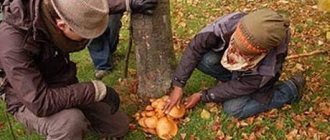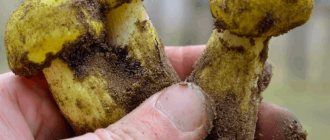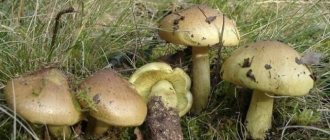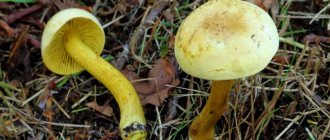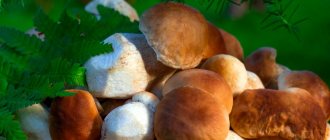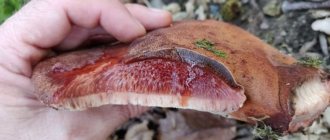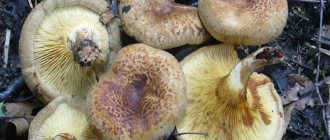Fat pig is one of those cases when the attitude towards the edibility of the mushroom is radically revised. For a long time, pigs were collected without any fear for pickling and frying; there were even those who preferred them to all other mushrooms (and some, especially stubborn ones, continue to collect them to this day).
However, new research methods have shown the presence in the pulp of pigs, both thick and thin, of poisons that have a cumulative effect. Up to a certain concentration, such poisons do not cause harm, but they tend to accumulate in tissues without being excreted from the body, and upon reaching a “critical mass” they have an effect, often harmful. In particular, muscarine was found in pigs, which, when accumulated, can seriously damage the kidneys and cause blood clotting.
Description of the mushroom
The thick or felted pig belongs to the Tapinella genus of the Tapinella family. It was given the Latin names Tapinella atrotomentosa, Paxillus atromentosus and Rhymovis atrotomentosa.
The cap reaches a diameter of 15 cm (the largest mushroom found has a diameter of 30 cm). Its shape in young specimens is convex, then becomes spade-shaped with a depressed middle. The edge is turned down, the surface has a velvety skin, the color is often rusty brown, sometimes ocher-brown.
The hymenophore on the lower side of the cap is lamellar, thick, branches towards the stalk. The plates of young mushrooms are creamy, can be ocher in color, later they reach brown tones, and become darker when pressed. The spores are yellow-brown.
The pulp can change shades from white to ocher, acquiring darker tones when cut. The structure is dense, odorless, and the taste is most often bitter.
The stem reaches 7 cm in length and 3.5 cm in diameter. In most cases, it is located on the side of the center of the cap, immersed in the soil. It has a cylindrical shape, slightly expanded at the bottom. It is rough to the touch, but velvety, the color is very dark, maybe even black.
If you treat the surface of the cap or stem with ammonia, they will acquire a bright lilac color. And contact with potassium hydroxide gives a green-black tone.
A little history
Back in 1783–1789, the German mycologist August Johann Georg Karl Batsch published his book on 200 species of mushrooms. Almost all the varieties were new to science, among them there was a description of the fat pig, and the book became one of the first reference books. Later, in 1992, Czech scientist Josef Shutara transferred the felt mushroom to another genus.
Dangerous twins
In many foreign sources, pig mushroom is quite reasonably considered an inedible mushroom or refers to fruits with toxic components that have not yet been studied. In Russia it is still classified as conditionally edible. It is not difficult to distinguish felt mushrooms; their individuality is quite pronounced.
| Name | Hat and leg | Hymenophore | Danger |
| Fat pig | The cap is brown with a brown tint, the leg is much darker, very thick, often located on the side | Lamellar, honey, yellowish | Conditionally edible |
| Thin pig | The hat always has an olive tint, the leg is much lighter, located in the center | Lamellar, brown with a yellow or rusty tint | Poisonous |
| Polish mushroom | The cap is chestnut, convex, the leg is light brown, with red-brown vertical stripes-fibers | Tubular | Edible |
| Green moss | The cushion-shaped cap is grayish or brown in color, located on a rather thin stalk, which is covered with a brown mesh | Tubular | Edible |
The greatest danger lurks if you confuse the felt pig with its thin sister. You should pick mushrooms in the forest very carefully, and under no circumstances take questionable specimens into your basket.
Differences between thin and thick pigs
A detailed comparison of two related and very similar pigs is presented in the table. It is difficult even for experienced mushroom pickers to distinguish them.
| Name | Felt pig | Slim pig |
| hat | Brown or brown, velvety, often cracks when ripe, the center has a depression | Brown with an olive, grayish or rusty tint. Dry, fluffy, sticky in the rain. First slightly convex, then flat |
| Leg | Thick, short, much darker than the cap, often shifted to the side, felt-like surface | Short, thin, matte, gray-yellow or olive, much lighter than the cap, less often the same color |
| Hymenophore | Yellowish, descending along the leg, darkening when touched | Pseudo-lamellar, the layer extends from the bottom of the cap. Color brown with a yellow or rusty tint, darkens when pressed |
| Pulp | Bitter, no odor, yellow, watery | Soft, no smell or taste, usually wormy in dry weather |
| Danger | Edibility has not been fully studied, but cases of poisoning have been recorded. | The toxins contained in the mushroom do not disappear after cooking, many deaths have been recorded, it should not be eaten, it is poisonous |
Often a thin pig causes allergies, accumulates large amounts of heavy metals and gradually throws all body functions out of balance. The first to die from eating this mushroom was the German mycologist Julius Schaeffer in 1944.
The main difference is still in the leg. When harvesting, you should pay special attention to it.
Is the pig edible or still poisonous?
Studying the scope of application of the culture we are considering, we can definitely say that the pig is poisonous to the human body.
Even 70 years ago, the plant was officially considered conditionally edible and was used as food, but since the first half of the 90s of the 20th century, cases of death among people serving such mushrooms on the table have become more frequent. The first death was recorded in the fall of 1944, after the consumption of a dangerous product by a mycologist from Germany, and in 1993 the plant was legally declared poisonous.
Numerous studies of the fruiting bodies of pigweed have revealed what is its catch. The fact is that the chemical composition of the forest fruit contains toxic muscarine and other lectins that are not destroyed even after long-term heat treatments of the fruit.
Also, the pulp of mushrooms is saturated with antigen, which is absorbed into membrane cells, after which the latter are destroyed thanks to the body’s natural defense system. Infected cells are identified as irritants, the body tries to get rid of them, as a result of which the blood suffers greatly, namely, the level of red blood cells decreases. The consequences of such processes can be:
- Acute renal failure;
- Liver damage, up to cirrhosis;
- Hemolytic anemia;
- Nephropathy;
- Poisoning by heavy metals accumulating in the pulp of the pig.
- Malfunctions of the cardiovascular system;
- Damage to some parts of the brain.
In addition to the listed diseases, the fungus can cause a serious allergic reaction, which cannot be overcome without immediate hospitalization.
Despite this, there are still desperate gourmets who prepare pigs for the winter. People adopt the experience of their grandparents, believing that there is no danger in the pulp of pigs. The harvested crop is soaked in cold water for several days, and the liquid is repeatedly replaced with a new one. Afterwards, the procedure is repeated with the addition of citric acid and salt - it is believed that in this way the maximum amount of toxins with metals “comes out” of the fruit. At the end of the preparation, the khavroshki are boiled at least three times, only after which they are usually marinated, fried or pickled, like all other edible forest delicacies.
Can pig meat be beneficial?
Going back several decades, we can analyze the “phantom” benefits of pigweed. Soviet scientists were convinced that the chemical composition of the mushroom is very rich in useful elements necessary for the normal functioning of the human body. Thus, one pig mushroom contains not only the previously discussed toxins, but also essential minerals and compounds (potassium, magnesium, sodium, iodine, phosphorus, zinc, iron, chromium, amino acids).
The presence of the listed "components" could and was once used:
- In the treatment of the heart and central nervous system.
- To normalize general hormonal levels (mainly female).
- After infection with viral and infectious diseases.
- To improve sleep and overall strengthen the body.
However, all of the above advantages instantly faded with the appearance of the first deaths from consuming toxic delicacies.
Assessing the benefits and harms of the plant in question, we can clearly conclude that the crop is dangerous to life. At the same time, it is impossible not to note cases when the forest product was used by traditional healers to obtain tinctures and extracts. There is an opinion that such unconventional medicines can help people suffering from malignant neoplasms.
Evaluation of taste qualities, medicinal properties, benefits and possible harm
The flesh of the fat pig is quite bitter and tough. For this reason, it is rarely collected and eaten. In light of recent statements by mycologists, the possibility of classifying it as an inedible species is being considered.
The most dangerous component of this mushroom is muscarine; it does not leave the fruit even after boiling or other heat treatment. A substance has also been found that forms antibodies in the blood, causing disease. In rare cases, deaths have been recorded after eating pork fat.
Harmful substances contained in felt mushroom tend to accumulate in the human body and are not naturally eliminated. Long-term use can cause poisoning and death.
ATTENTION! Not for consumption by children, pregnant or nursing mothers!
Treatment for poisoning
An ambulance should be called as soon as the first symptoms of poisoning appear. Before the doctors arrive, the patient is given plenty of fluids to drink. Strong herbal tea without sugar or purified (filtered) water at room temperature has a good effect. This allows you to cleanse the stomach and remove more toxic substances.
To stimulate the release of toxic substances from the body, the following means are used:
- Smecta;
- Enterosorbent;
- Enterosgel;
- activated carbon (1 tablet per 10 kg of weight).
In case of severe poisoning, a laxative or enema helps. This significantly enhances the release of harmful substances from the stomach.
Strong herbal tea without sugar helps with poisoning
Attention! When providing first aid, the following is strictly prohibited:
- Take medications that improve (fasten) the functioning of the gastrointestinal tract (digestion will delay the entry of poison into the blood).
- Give enemas to older people.
- Cause a gag reflex in children under 3 years of age and in pregnant women.
A group of doctors has been called to hospitalize a patient who has been poisoned by mushrooms. At a medical facility, he is prescribed drug detoxification. The type of procedure depends on the amount of toxic substances in the body, as well as the physiological characteristics of the patient. Advice. Save the remains of the dish with mushrooms that caused poisoning for laboratory testing.
Detoxification methods:
- gastric lavage;
- hemodialysis;
- enema.
Recovery after poisoning
After detoxification, patients are restored to water and electrolyte (salt) balance in the body (we can say that the water-salt balance is being restored). For this purpose, antibiotics are used in the form of tablets and injections. In acute cases of mushroom poisoning, IVs are given. To recover, the patient is prescribed a special diet.
Dietary rules after poisoning with pig fat:
- You should not eat fried, smoked, fatty or spicy foods;
- giving up alcohol and cigarettes;
- eating boiled or steamed food;
- You can only eat chopped fruits and vegetables.
Primary processing and preparation
If you nevertheless decide to cook the mushroom, to finally decide for yourself whether it is edible (which is very dangerous), you should first soak the fruits for 1–2 days, periodically changing the water.
The second method: keep it in salted water for 5 hours, during which time it should be changed 3 times.
It will also take a long time to cook the mushrooms, preferably twice for 30 minutes each with changing the water. During the repeat process, add salt to taste. After this, the pork can be fried or marinated.
The recipe for the first method is this.
Ingredients:
- boiled mushrooms – 0.5 kg;
- onion – 200 g;
- butter – 50 g;
- salt, pepper to taste;
- favorite greens, optional.
Cooking steps:
- Melt butter in a frying pan, add diced pork.
- Fry over medium heat for 7 minutes.
- Finely chop the onion and add to the mushrooms.
- After 10 minutes, add salt and pepper.
Remove the mixture from the heat, sprinkle with herbs and serve with boiled potatoes.
In order to marinate felt pigs, you will need:
- mushrooms – 1 kg;
- salt – 1 tbsp. l.;
- sugar – 2 tbsp. l.;
- vinegar - 3 tbsp. l.;
- vegetable oil – 6 tbsp. l.;
- black peppercorns – 15 grains;
- laurel leaves – 3 pcs;
- cloves – 3 pcs;
- water – 600 ml.
How to cook:
- Add all the spices to the water and bring to a boil.
- When the salt and sugar are completely dissolved, you can add the mushrooms.
- Boil for 15 minutes, remove from heat.
- Place the fruits in sterilized jars.
- Remove bay leaves from the marinade and pour the product over them.
After this, you can sterilize the jars for 20 minutes and roll them up with metal lids or close them with high-quality nylon lids.
After cooling completely, take it to a cool room or place it on the bottom shelf of the refrigerator. After 3 days you can try.
IMPORTANT! Consumption of mushrooms that have not been fully studied is dangerous to life and health. They should not be given to children, the elderly, or those with gastrointestinal diseases.
Literature
- Gapienko O. S., Shaporova Y. A.
Flora of Belarus. - Minsk: Belaruskaya Navuka, 2012. - T. 1. - P. 69. - 199 p. — ISBN 978-985-08-1482-1. - Roody WC
Mushrooms of West Virginia and the Central Appalachians. - The University Press of Kentucky, 2003. - P. 148. - 520 p. — ISBN 0-8131-9039-8. - Bessette, A.;
Bessette, AR; Fischer, D. W. Mushrooms of Northeastern North America. - Syracuse University Press, 1997. - P. 220. - 582 p. — ISBN 0815603886.
